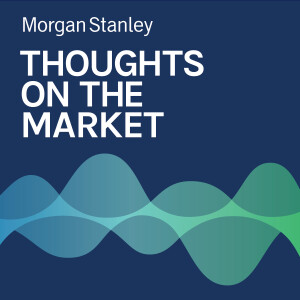
Ellen Zentner: Is the U.S. Headed for a Soft Landing?
 2022-12-02
2022-12-02
While 2022 saw the fastest pace of policy tightening on record, has the Fed’s hiking cycle properly set the U.S. economy up for a soft landing in 2023?
----- Transcript -----
Welcome to Thoughts on the Market. I'm Ellen Zentner, Morgan Stanley's Chief U.S. Economist. Along with my colleagues, bringing you a variety of perspectives, today I'll discuss our 2023 outlook for the U.S. economy. It's Friday, December 2nd, at 10 a.m. in New York.
Let's start with the Fed and the role higher interest rates play in the overall growth outlook. The Fed has delivered the fastest pace of policy tightening on record and now feels comfortable to begin slowing the pace of interest rate increases. We expect it to step down the pace to 50 basis points at its meeting later this month and then deliver a final hike in January to a peak rate of between 4.5 and 4.75%. But in order to keep inflation on a downward trajectory, the Fed will likely keep rates at that peak level for most of next year. This shift to a more cautious stance from the Fed we think will help the U.S. economy narrowly miss recession in 2023. And we think only in the back half of 2024 will the pace of growth pick back up as the Fed gradually reduces the policy rate back toward neutral, which is around 2.5%. Altogether, we forecast 2023 GDP growth of just 0.3% before rebounding modestly to 1.4% in 2024.
One bright spot in the outlook is that inflation seems to have reached a turning point. Mounting evidence points to a slowing in housing prices and rents, though they continue to drive above target inflation. Core goods inflation should turn to disinflation as supply chains normalize and demand shifts to services and away from goods. Used vehicle prices are a big contributor to lower overall inflation in our forecast, as our motor vehicle analysts believe that used car prices could be down as much as 10 to 20% next year. So overall, we expect core PCE - or personal consumption expenditures inflation - to slow from 5% this year, to 2.9% in 2023, and further to 2.4% in 2024.
Throughout 2022, rising interest rates have raised borrowing costs, which has weighed on consumption. And we expect that to continue into 2023 as the cumulative effects of past policy hikes continue to flow through to households. On the income side, we expect a rebound in real disposable income growth in 23, because inflation pressures abate while job growth continues to be positive. So if I put those together, slower consumption and rising incomes should lift the savings rate from 3.2% this year, to 5.1% in 2023, and 6.2% in 2024. So households will start to rebuild that cushion.
Now we're in the midst of a sharp housing correction, and we expect a double digit decline in residential investment to continue. But we don't expect a commensurate drop in home valuations. Our housing strategies predict just a 4% drop in national home prices in 2023, and further price declines are likely in the years ahead, but that's a much milder drop in home valuations compared with the magnitude of the drop off in housing activity. So we think that residential wealth, real estate wealth will continue to be a strong backdrop for household balance sheets. Now going forward, mortgage rates will start to fall again after reaching these peaks around 7%. And with healthy job gains, and that increase in real disposable income growth affordability should begin to ease somewhat, we think starting in the back half of 2024.
Turning to the labor market, while signs of falling inflation is important to the Fed, so are signs that the labor market is softening and we expect softer demand for labor and further labor supply gains to create the slack in the labor market the Fed is looking for. So we expect job growth will likely fall below the replacement rate by the second quarter of 2023, pushing up the unemployment rate to 4.3% by the end of next year and 4.4% by the end of 2024.
In sum, we think the U.S. economy is at a turning point, but not a turning point toward recession, a turning point toward what is likely to prove to be two sluggish years of growth in the economy. The Fed's hiking cycle is working as it should. The labor market is softening. The inflation rate is coming down. And we think that puts the U.S. economy on track for a soft landing in 2023.
Thanks for listening. If you enjoy the show, please leave us a review on Apple Podcasts, and share Thoughts on the Market with a friend or colleague today.
More Episodes
 2024-11-08
2024-11-08
 2024-11-07
2024-11-07
 2024-11-05
2024-11-05
 2024-11-01
2024-11-01
 2024-10-31
2024-10-31
 2024-10-30
2024-10-30
 2024-10-29
2024-10-29
 2024-10-28
2024-10-28
 2024-10-25
2024-10-25
 2024-10-23
2024-10-23
 2024-10-22
2024-10-22
 2024-10-15
2024-10-15
 2024-10-14
2024-10-14
Create your
podcast in
minutes
- Full-featured podcast site
- Unlimited storage and bandwidth
- Comprehensive podcast stats
- Distribute to Apple Podcasts, Spotify, and more
- Make money with your podcast
It is Free
- Privacy Policy
- Cookie Policy
- Terms of Use
- Consent Preferences
- Copyright © 2015-2024 Podbean.com




